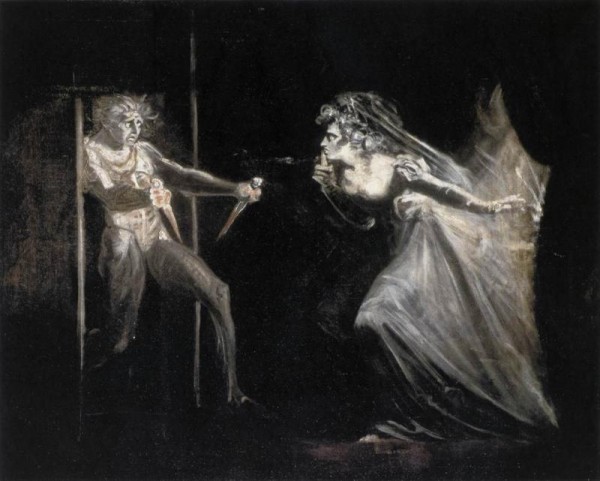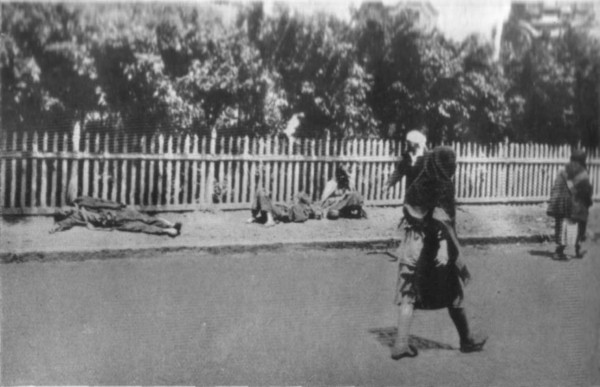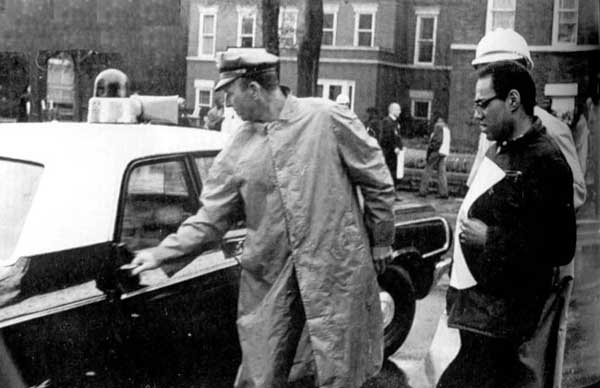 I am a fortunate man from a fortunate generation; all my life the rule of law has prevailed, my father worked steadily, we were raised within a dream of middle-class security and our few nightmares vanished upon awakening. Then, by and large the children I taught ate well, attended college and their station in life rose as their parents had risen. They were safe at night.
I am a fortunate man from a fortunate generation; all my life the rule of law has prevailed, my father worked steadily, we were raised within a dream of middle-class security and our few nightmares vanished upon awakening. Then, by and large the children I taught ate well, attended college and their station in life rose as their parents had risen. They were safe at night.
Lady Macbeth With the Daggers, Henry Fuselli, 1812
When I became a teacher, I was faced with the challenge of sometimes making other frightful worlds real to students whose worries were always more personal than public and universal. How was one supposed to teach Macbeth, or the Holocaust, or about the one a.m. disappearances of ordinary human beings endemic to totalitarian states, or The Grapes of Wrath or about the slaughterhouse of Stalingrad?
I do not know how to imagine these places unless they can be made personal. I do not know how well-fed, secure American kids can understand them unless the personal, real nature of morally reprehensible actions can be explicitly connected to their own stories.*
As teachers we have to find a way to make these books and events explicable to new generations. They need the historical contexts, the facts and figures, the description of processes and political theory, the stories of individual combatants and killers and victims, but then they need to be viscerally connected so that they can imagine themselves in similar positions. They have to be able to see and feel themselves inside these alien realities.
They must tell their stories of fear or cruelty and violence. They must witness. They have to get down to the bone. But you must tell yours to begin, and so, one of my stories first.**
Until I finished second grade we lived in Myerstown on old Rt. 422. Directly across from our home was a country lane that led past fields and woods to railroad tracks and a creek. Someone had once dug clay out of a pit that connected to the lane. A spiraling access road led down to the bottom. In the winter we sledded there, loving the tight right curve that helped us pick up speed.
One winter day school was cancelled. Snow had fallen heavily all night. By nine the next morning my brother and sister and I were dressed for sledding. We walked across the empty highway, down the lane, and to the edge of the pit. Neighborhood kids were already lined up, laughing, jumping on their sleds and disappearing around the curve.
Someone, I never found out who, but he must have done it that morning for their colors were a deep oxygen blood red and cobalt blue, someone had shot two cardinals and a blue jay, tied their feet with wire and hung them upside down directly over the sled run where children came to play. I was repulsed and mesmerized and utterly unable to understand why anyone would have done this. Even at 7 or 8 I think I understood on my child’s simple level that this was killing done for killing’s sake, for the pleasure of killing, for the thoughtless sake of filling up time with heedless action, for killing because he could and then for displaying the power he enjoyed implicit in their deaths in the turning bodies of three birds.
Now comes the leap.
In his history Bloodlands Timothy Snyder describes the murder of fourteen million men, women and children by Stalin’s Soviet Union and Hitler’s Germany in the area encompassing central Poland to western Russia, including the Baltic States and the Ukraine, from 1933 to 1945. He describes the mechanisms by which this murder was accomplished and the ideological motivations that were its engines, the key to understanding them being that both States sought “… to deprive groups of human beings … their right to be regarded as human (387).”@

In the Ukraine, 1933, “the corpses of the starving lie in the road-side, the passers-by no longer pay them attention.”
In the Soviet Union Stalin and others were driven by this incomprehensible political hubris – we are driving history. We are the messianic engine of history. Therefore we have the right to kill. On a practical level that hubris looks like this logical machine: during the great man-made famine of 1933, peasant Ukrainians must die so that the USSR can industrialize, so that the Party/nation can survive, so that it can grow stronger, so that it can lead the revolution. In this logical structure a peasant is reduced to “…containers of calories that should be emptied (178).”@
Hitler was driven by this incomprehensible racial hubris – we are the master race. All other inferiors, Jews, Slavs, Poles, must give way before us. The German race is by natural rights deserving of supremacy. All others must be exterminated or enslaved. On Nazi Germany’s practical level that hubris looked like this: A Hunger Plan was formulated in May of 1941: “During and after the war on the USSR, the Germans intended to feed German soldiers and … civilians by starving the Soviet citizens they would conquer…. (162).” “The Hunger Plan involved the “extinction of industry as well as a great part of the population in the deficit regions (163).”@
Mass murder was a political and moral choice made by political elites and enforced by hundreds of thousands of mostly ordinary men (and a few women). Weed out the sadists and psychopaths and the fanatics. Ordinary men committed most of these murders.
In his preface Snyder describes one of his three fundamental methods of study – an “acceptance of the irreducible reality of choice in human affairs (xviii)” — lots of ordinary men operating by choice performed these deeds.@
As a teacher, how does one make sense of these episodes to a classroom full of bored, safe, 16 year olds, or for that matter to anyone of us who live in the comfort provided by peace and law:
“Only two or three Jews who disembarked at Belzec survived: about 434,508 did not (260).”@
The Communist Party created zones of starvation in the Ukraine in 1933; “in that spring…people died at a rate of more than ten thousand a day (47).”@
Or this, a description of one of the Soviet executioners of Polish officers:
“The chief executioner at Kalinin, whom the prisoners never saw, was Vasily Blokhin. … He wore a leather cap, apron and long leather gloves to keep the blood and gore from himself and his uniform. Using German pistols, he shot, each night, about two hundred and fifty men, one after another (137).”@
A reader looks on in an awful kind of trance at one avalanche after another of indestructible facts:
“Yet there is ample evidence in modern experience that many people are ready to kill others to order, once satisfied that this fulfills the wishes of those whose authority they accept. Hundreds of thousand of Russians were complicit in the deaths of millions of their fellow countrymen at the behest of Stalin and Beria, before the Holocaust was thought of (503).”#
Sometimes an instance of honesty is so shocking that you have to read it again and again:
“Hans Frank, the Nazi ruler of Poland, wrote in his 1942 diary: Humanity is a word that one dares not use … The power and certainty of being able to use force without any resistance are the sweetest and most noxious poison that can be introduced into any government. …it captures the exhilaration experienced by many German and Japanese on finding themselves , together with their local acolytes, occupying posts which conferred absolute power of life and death (484).”#
This incident strikes my heart with a bolt of recognition because in some way I can see these victims more clearly:
“One investigation in Leningrad led to the shooting (not the deportation) of thirty-five people who were deaf and dumb (84).”@
Your students have to be able to imagine these scenes, and it is your responsibility to find a way to reach their imaginations. You have to find a way to help them make the empathetic leap into the lives of the peasants, the Jews, the Polish Officers, the deaf and dumb. As important, and much more difficult, you have to help them find a path into the minds of the killers, those ordinary men. That is where the deepest act of imagination has to take place. You cannot leave the killers as faceless monsters who emerge from a moral darkness, conduct their nightmares and then return to darkness. If students do not have some deep understanding of them, they cannot understand the larger actions of the Soviet and German governments. Snyder argues that “… a legitimate comparison of Nazi Germany and Stalinist Soviet Union must not only explain the crimes but embrace the humanity of all concerned … including the victims, perpetrators, bystanders and leaders (387).”@
Maybe your class will understand this – political murder involves embracing a political ideology that mutates and then metastasizes, becoming theological and then sacred. Maybe it has its origin in the power of the group where all others conform in a sea of a collective and delirious yes’s – in this way one, alone, is unable to say no. Or maybe they will understand this — a malignant authority creates “others” as scapegoats and then gives permission for the crossing of moral boundaries for the destruction of the “others.”
The bodies of dead birds set aside as spectacles by some freak furnished me with an imaginative window into the terrors experienced by “others” like me. The critical words in that sentence are “like me,” and by extension like you and like your students. But you cannot leave them here. This bloody human wilderness is far too harsh a place to be left as their conclusion about the nature of human beings.
 Now tell them about Bob Moses, alone in the Mississippi delta, about Hugh Thompson, Raoul Wallenberg, Anna Akhmatova and Nazedhda Mandelstam, alone and facing down beasts.
Now tell them about Bob Moses, alone in the Mississippi delta, about Hugh Thompson, Raoul Wallenberg, Anna Akhmatova and Nazedhda Mandelstam, alone and facing down beasts.
Bob Moses being arrested.
The world has not been ended by men doing evil; goodness rises up. Men and women of conscience do step forward and show us how not to be afraid and the language by which one might say “no more”.
*If you teach children who must dodge bullets and terrible men and who know about hunger from the experience of their own bodies, then their imaginations are already attuned to the felt experience of a dangerous life.
**There is no suggestion here, none, that a moral or psychological equivalency exists between the actions taken by Macbeth or the USSR and Hitler’s Germany and the stories that you and your students tell in your well-lit classrooms, but “the error bred in the bone” of human beings endures in all of us, teacher and student, parent and administrator, custodian and school board director. We too are ordinary men and women.
@Bloodlands: Europe Between Hitler and Stalin by Timothy Snyder
#Inferno: A World At War by Max Hastings
gush, Mike, You wrote about something I have been thinking about all week. How do you explain to people , safe in the USA, who have never experienced the cruelty and the oppression that you talk about? I have read some of the blogs talking about how “terrible” our country is, how our freedoms are being taken away because of the NSA thing going on right now. These people have NO idea, how many checks and balances we have as a government, how our traditions and culture would not let this happen. They have no frame of reference because they haven’t read anything or gone anywhere. How wonderful America is!!!
Our vulnerability as a nation lies in the very fact that our children (and for the most part, those of us currently alive), never really have experienced insane despots or murderers the likes of Stalin, Mao, Hitler. And so, we take for granted the incredible freedoms and grace we have here in the US. But our freedom is eroding, and the unpunished actions by the IRS and the NSA are plain evidence that the corruption is now systemic…I am no longer optimistic for America’s future.